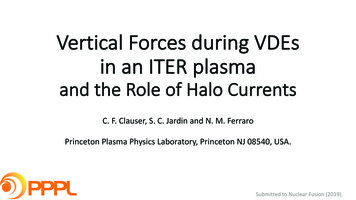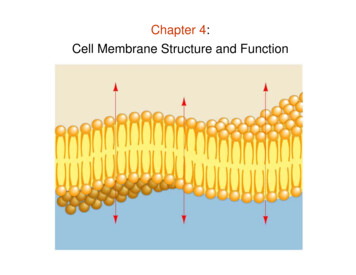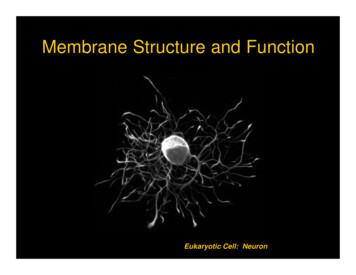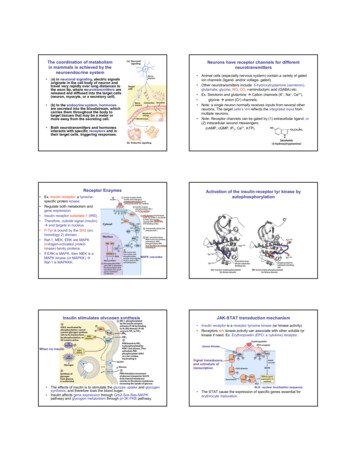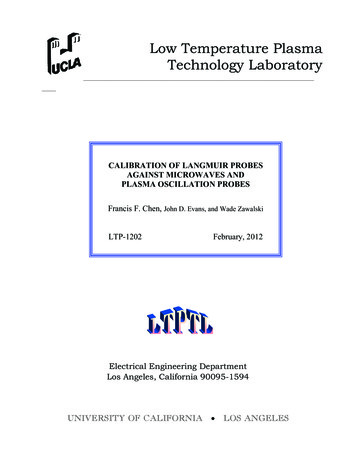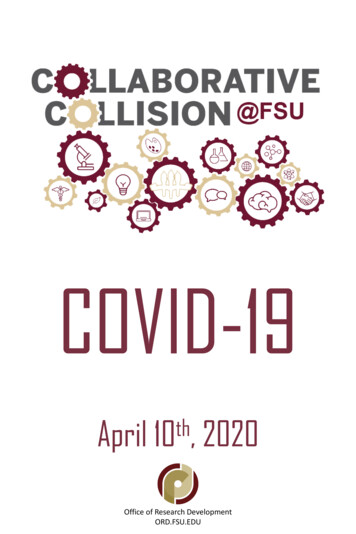
Transcription
C H A P T E RO N EThe Membrane Receptor for PlasmaRetinol-Binding Protein, A New Typeof Cell-Surface ReceptorHui Sun*,†,‡,§ and Riki Kawaguchi*,†Contents1. Introduction2. Diverse Physiological Functions of Vitamin A, a Molecule Essentialfor Vertebrate Survival2.1. Alcohol forms of vitamin A2.2. Aldehyde forms of vitamin A2.3. Acid forms of vitamin A2.4. Ester forms of vitamin A2.5. Pathological effects of vitamin A deficiency3. Retinol-Binding Protein, the Specific Carrier of Vitamin A in Blood4. Diverse Evidence for the Existence of an RBP Receptor thatMediates Vitamin A Uptake5. Identification of RBP Receptor5.1. Identification of high-affinity RBP receptor as STRA65.2. STRA6 in the eye5.3. STRA6 in the reproductive systems5.4. STRA6 in the nervous system5.5. STRA6 in the lymphoid organs5.6. STRA6 in the skin5.7. STRA6 in the lung5.8. STRA6 in the kidney5.9. STRA6 in the heart6. Structure and Function Analysis of the RBP Receptor’sInteraction with RBP6.1. Transmembrane topology of STRA66.2. The RBP-binding domain in STRA634456667912121317171818191919202020* Department of Physiology, David Geffen School of Medicine at UCLA, Los Angeles, California, USAJules Stein Eye Institute, David Geffen School of Medicine at UCLA, Los Angeles, California, USABrain Research Institute, David Geffen School of Medicine at UCLA, Los Angeles, California, USA}Howard Hughes Medical Institute, David Geffen School of Medicine at UCLA, Los Angeles, California, USA{{International Review of Cell and Molecular Biology, Volume 288ISSN 1937-6448, DOI: 10.1016/B978-0-12-386041-5.00001-7#2011 Elsevier Inc.All rights reserved.1
2Hui Sun and Riki Kawaguchi6.3. STRA6 mutants associated with human disease6.4. RBP’s interaction with its receptor7. Pertinent Questions Related to RBP Receptor7.1. Retinol has the ability to diffuse through membranes. Why is itnecessary to have a multitransmembrane domain protein(the RBP receptor) to assist its transport?7.2. Why does RBP need a high-affinity receptor for vitamin Auptake?7.3. Why is the interaction between RBP and its receptor transient?7.4. Why are the phenotypes of patients with RBP mutationsdifferent from patients with RBP receptor mutations?7.5. Retinoid has the ability to diffuse systemically. Why did such acomplicated mechanism (RBP/STRA6) to deliver vitamin A tocells evolve?7.6. If the RBP/STRA6 system functions to specifically delivervitamin A to target organs, why does excessive vitamin Auptake cause toxicity?7.7. What is the role of megalin in vitamin A uptake?8. RBP Receptor as a Potential Target in Treating Human Diseases8.1. Visual disorders8.2. Cancer8.3. Skin diseases8.4. Lung diseases8.5. Immune disorders8.6. Neurological disorders8.7. Diabetes9. Concluding 82930303031313131323232AbstractVitamin A is essential for diverse aspects of life ranging from embryogenesis tothe proper functioning of most adult organs. Its derivatives (retinoids) havepotent biological activities such as regulating cell growth and differentiation.Plasma retinol-binding protein (RBP) is the specific vitamin A carrier protein inthe blood that binds to vitamin A with high affinity and delivers it to targetorgans. A large amount of evidence has accumulated over the past decadessupporting the existence of a cell-surface receptor for RBP that mediatescellular vitamin A uptake. Using an unbiased strategy, this specific cell-surfaceRBP receptor has been identified as STRA6, a multitransmembrane domainprotein with previously unknown function. STRA6 is not homologous to anyprotein of known function and represents a new type of cell-surface receptor.Consistent with the diverse functions of vitamin A, STRA6 is widely expressed inembryonic development and in adult organ systems. Mutations in humanSTRA6 are associated with severe pathological phenotypes in many organs
Receptor for Plasma Retinol-Binding Protein3such as the eye, brain, heart, and lung. STRA6 binds to RBP with high affinityand mediates vitamin A uptake into cells. This review summarizes the history ofthe RBP receptor research, its expression in the context of known functions ofvitamin A in distinct human organs, structure/function analysis of this new typeof membrane receptor, pertinent questions regarding its very existence, and itspotential implication in treating human diseases.Key Words: Vitamin A, Retinoid, RBP, STRA6, Membrane receptor, Retinol,Anophthalmia, Mental retardation. ß 2011 Elsevier Inc.1. IntroductionThe molecular mechanism for vitamin A’s physiological function wasfirst elucidated for vision (Wald, 1968). Vitamin A’s multitasking ability kepton surprising researchers starting almost a century ago. Today, biologicalfunctions of vitamin A have been discovered in almost every vertebrateorgan system. In addition to vision, known biological functions of vitaminA include its roles in embryonic growth and development, immune competence, reproduction, maintenance of epithelial surfaces, and proper functioning of the adult brain (Drager, 2006; Duester, 2008; Mangelsdorf et al.,1993; Napoli, 1999; Ross and Gardner, 1994). Since vitamin A derivativeshave profound effects on cellular growth and differentiation, vitamin A alsoplays positive or negative roles in a wide range of pathological conditions,such as visual disorders (Travis et al., 2006), cancer (Love and Gudas, 1994;Niles, 2004; Verma, 2003), infectious diseases (Stephensen, 2001), diabetes(Basu and Basualdo, 1997; Yang et al., 2005), teratogenicity (Nau et al.,1994), and skin diseases (Chivot, 2005; Orfanos et al., 1997; Zouboulis,2001). Except for vision, which depends on the aldehyde form of vitamin A,most of these physiological or pathological functions can be ascribed toretinoic acid’s effects on nuclear hormone receptors (Chambon, 1996;Evans, 1994). New biological functions are still being discovered for vitaminA derivatives. For example, it was recently discovered that retinal inhibitsadipogenesis (Ziouzenkova et al., 2007).Plasma retinol-binding protein (RBP), a high-affinity vitamin A bindingprotein, is the principal means of vitamin A transport in the blood, and isresponsible for a well-regulated transport system that helps vertebrates adapt tofluctuations in vitamin A levels (Blomhoff et al., 1990). RBP specifically bindsto vitamin A, effectively solubilizes it in aqueous solution, and protects it fromenzymatic and oxidative damage (Goodman, 1984). In addition, RBPwas recently discovered to play a role in insulin resistance (Yang et al.,2005). Using an unbiased strategy combining specific photo-cross-linking,high-affinity purification, and mass spectrometry, the high-affinity cell-surface
4Hui Sun and Riki KawaguchiRBP receptor has been identified as STRA6, a protein with a multitransmembrane domain architecture typical of channels and transporters, but nothomologous to any protein of known function. STRA6 binds to RBP withhigh affinity and mediates cellular uptake of vitamin A from the vitamin A/RBP complex (holo-RBP). Consistent with the diverse functions of vitaminA, human STRA6 mutations cause severe pathological phenotypes includingthe absence of eyes (anophthalmia), mental retardation, congenital heartdefects, lung hyperplasia, and intrauterine growth retardation (Golzio et al.,2007; Pasutto et al., 2007).In this review, we provide a summary of current knowledge of vitaminA and RBP, describing in detail our current knowledge of the RBPreceptor including its identification, the unique features of its functionboth as a membrane receptor and a membrane transporter, and the relationships between its tissue distribution and the known organ specific functionsof vitamin A. In addition, we provide answers to some pertinent questionsrelated to the RBP receptor and its potential relationships with humandiseases.2. Diverse Physiological Functions of Vitamin A,a Molecule Essential for VertebrateSurvivalVitamin A has alcohol, aldehyde, acid, and ester forms (Fig. 1.1).Some forms have direct biological activities and other forms serve asimportant reaction intermediates or as the storage form of vitamin A.Known functions of vitamin A and its derivatives and pathological effectsof vitamin A deficiency are discussed in the following sections.2.1. Alcohol forms of vitamin AA main function of the alcohol form of vitamin A is to serve as the substratefor RBP for delivery in the blood. The fact that retinol evolved to be themajor transport form of vitamin A is likely due to the fact that it is less toxicthan retinal and retinoic acid. Free retinal has been shown to be highly toxic(Maeda et al., 2008, 2009). Retinoic acid is the most biologically activeform of vitamin A and is also the most toxic form. In addition, retinol can beconverted to retinal and retinoic acid.Retinol also serves as an intermediate in the visual cycle for chromophore regeneration (Chen and Koutalos, 2010; Chen et al., 2005). Inaddition, the alcohol derivatives of vitamin A have biological activitiesdistinct from retinoic acid. For example, they control the growth of Blymphocytes (Buck et al., 1990, 1991) and function as a survival factor in
5Receptor for Plasma Retinol-Binding ProteinOCH2OHCH2OCRRetinyl esterAll-trans retinolCHO11-cis retinalAll-trans retinalCHOCOOHAll-trans retinoic acid9-cis retinoic acidCOOHFigure 1.1 Vitamin A and its major derivatives that have biological activities or serveas important intermediates.serum for fibroblasts (Chen et al., 1997). Anhydroretinol, another physiological metabolite of vitamin A, can induce cell death (Chen et al., 1999).Another known function of vitamin A is in the testis. Degeneration ofgerminal epithelium in testis caused by vitamin A deficiency can be reversedby vitamin A but not by retinoic acid (Griswold et al., 1989; Howell et al.,1963). One likely explanation for the distinction between retinol andretinoic acid is that retinol can be efficiently transported via RBP/retinolin vivo but retinoic acid cannot. In addition, retinol can also have biochemical functions distinct from the precursor to retinoic acid (Chen and Khillan,2010; Hoyos et al., 2005). It was recently discovered that retinol, but notretinoic acid, regulates BMP4 expression in male germ line cells (Baleatoet al., 2005). In addition, retinol, but not retinoic acid, prevents thedifferentiation and promotes the feeder-independent culture of embryonicstem cells (Chen and Khillan, 2008, 2010; Chen et al., 2007).2.2. Aldehyde forms of vitamin APhotoreceptor cells in the retina use 11-cis retinal as the chromophore(Dowling, 1966). In addition, the aldehyde form of vitamin A serves as anintermediate in the synthesis of retinoic acid, the vitamin A derivative withthe most diverse biological functions. It was also recently discovered toinhibit adipogenesis (Ziouzenkova et al., 2007).
6Hui Sun and Riki Kawaguchi2.3. Acid forms of vitamin ARetinoic acid (vitamin A acid) was initially known as a morphogen indevelopment (Marshall et al., 1996; Reijntjes et al., 2005). Retinoic acidis essential in organogenesis (Maden, 1994). The nuclear receptors forretinoic acid were discovered in 1987 (Giguere et al., 1987; Petkovichet al., 1987). Nuclear retinoic acid receptors regulate the transcriptions ofa large number of genes (Chambon, 1996; Evans, 1994). Retinoic acid canboth stimulate or suppress mitogenesis depending on the cellular context(Chen and Gardner, 1998). In addition to gene transcription, retinoic acidmay also mediate its effect by retinoylation of proteins (Takahashi andBreitman, 1994). Recently, retinoic acid was discovered to acutely regulateprotein translation in neurons independent of its roles in regulating genetranscription (Aoto et al., 2008; Chen et al., 2008). In addition to itsdevelopmental roles, retinoic acid is also important in the function of manyadult organs such as the nervous system, the immune system, the reproductivesystem, the respiratory system, and the skin. These functions will be discussedin detail in the context of the RBP receptor.2.4. Ester forms of vitamin ARetinyl ester is the major storage form of vitamin A inside cells (Battenet al., 2004; Liu and Gudas, 2005; O’Byrne et al., 2005; Ruiz et al., 2007)and is an alternative form for vitamin A delivery. However, vitamin Adelivery through retinyl ester is associated with toxicity (Goodman, 1984;Smith and Goodman, 1976).2.5. Pathological effects of vitamin A deficiencyVitamin A deficiency affects a wide range of organ systems in vertebrates(West, 1994; Wolbach and Howe, 1925). For humans, the most wellknown effects of vitamin A deficiency are night blindness (Dowling,1966) and childhood mortality and morbidity (Sommer, 1997a). Evenmild vitamin A deficiency (presymptomatic for ocular phenotypes) has alarge impact on childhood mortality (Sommer, 1997a). This is due tovitamin A’s role in boosting immunity (Semba, 1999; Stephensen, 2001).It was estimated that 140 million children and more than 7 million pregnantwomen suffer from vitamin A deficiency every year worldwide and 1.2–3million children die each year due to vitamin A deficiency alone (Sommerand Davidson, 2002). Maternal vitamin A deficiency is associated withmaternal mortality and congenital defects in multiple organs in newbornchildren. In adults, vitamin A deficiency can affect brain function. Experiments in animal models show that vitamin A deficiency can lead to profoundimpairment of hippocampal long-term potentiation and a virtual abolishment
Receptor for Plasma Retinol-Binding Protein7of long-term depression (Misner et al., 2001). Consistently, vitamin A deficiency leads to impairment in special learning and memory (Cocco et al.,2002). In addition, vitamin A deficiency can lead to abnormal functions of thelung (Biesalski, 2003), the skin (Vahlquist, 1994), the thyroid (Morley et al.,1978), and the male and female reproductive systems (Livera et al., 2002;Wolbach and Howe, 1925).3. Retinol-Binding Protein, the Specific Carrierof Vitamin A in BloodSince mammals cannot synthesize vitamin A, the only sources ofvitamin A are from the diet and maternal vitamin A (which is also ultimatelyfrom the diet). The majority of dietary vitamin A is stored in the liver.Vitamin A is insoluble in aqueous media, is chemically unstable, and is toxicto cells at low levels. Vitamin A transport to different cell types needs to beprecisely regulated because too little or too much vitamin A can be detrimental both to cellular survival and function (Goodman, 1984). PlasmaRBP is a member of lipocalin superfamily (Newcomer and Ong, 2000).RBP is the principal means of transporting vitamin A in the blood and isresponsible for a well-regulated transport system that helps vertebrates toadapt to fluctuations in vitamin A level (e.g., during seasonal changes innatural environments; Blomhoff et al., 1990). RBP specifically binds tovitamin A and effectively solubilizes vitamin A in aqueous solution andallows for a plasma vitamin A concentration 1000-fold higher than wouldoccur for free vitamin A. RBP also protects vitamin A from enzymatic andoxidative damage (Goodman, 1984). RBP helps to maintain a physiologicalrange of vitamin A concentration so that vitamin A concentration is stabledespite variable intake from food (Redondo et al., 2006). Another functionof the RBP system is to decrease the toxicity associated with unregulateddistribution of vitamin A (Dingle et al., 1972; Goodman, 1984). Experiments in rats (Mallia et al., 1975) and a study of human patients withhypervitaminosis A (Smith and Goodman, 1976) both suggested thatmore toxicity is associated with vitamin A delivery independent of RBP.An excessive dose of vitamin A is toxic in vivo only when the level ofvitamin A in the circulation is presented to cells in a form other than boundto RBP, such as in retinyl esters (Goodman, 1984).RBP in complex with vitamin A (holo-RBP) is mainly produced in theliver, but is also produced in many other organs. For example, RBP ishighly expressed in adipose tissue (Makover et al., 1989). However, extrahepatic RBP cannot mobilize the vitamin A stores in liver (Quadro et al.,2004). The exact roles of RBP secreted by tissues other than liver are notclear. One exception is that RBP secreted by adipocytes has recently been
8Hui Sun and Riki Kawaguchifound to be an adipokine for insulin resistance (Tamori et al., 2006; Yanget al., 2005). This is a function of RBP other than vitamin A delivery. HoloRBP in the blood is in complex with the thyroxine binding proteintransthyretin (TTR), which is also called prealbumin. This complexincreases the molecular weight of holo-RBP and reduces its loss throughglomerular filtration in the kidney. The crystal structure of holo-RBP incomplex with TTR has been determined (Fig. 1.2; Monaco et al., 1995;Naylor and Newcomer, 1999; Zanotti and Berni, 2004).The main conclusion from studies of RBP knockout mice is that loss ofRBP makes mice extremely sensitive to vitamin A deficiency. RBP knockout mice cannot mobilize the hepatic vitamin A store (Quadro et al., 1999).Even with a nutritionally complete diet, knockout mice have a dramaticallylower serum vitamin A level, similar to the level in the later stages of vitaminA deficiency in humans. Given the role of vitamin A in immune regulationand the susceptibility of vitamin A-deficient children to infection beforevisual symptoms (Semba, 1998; Sommer, 1997a; Stephensen, 2001), it islikely that the immune system is also sensitive to RBP defect under vitaminA-sufficient conditions. Indeed, the circulating immunoglobulin level inRBP knockout mice is half of that in the wild-type mice even undervitamin A sufficiency (Quadro et al., 2000). It will be interesting to systematically study the effects of loss of RBP functions on mouse susceptibility toinfection, which is well correlated with vitamin A status in humans (Semba,1999; Sommer, 1997a; Stephensen, 2001). As demonstrated by a LacZreporter system for retinoic acid level, there is a dramatic decrease in retinoicacid level in the developing brain of RBP knockout mice even undervitamin A-sufficient conditions (Quadro et al., 2005). Therefore, it will beinteresting to test whether these mice have any cognitive defects in adulthood. In addition, RBP knockout mice have abnormal heart development(Wendler et al., 2003) and impaired vision (Quadro et al., 1999, 2003).TTRRetinolTTRRetinolNCRBPTTRTTRRBPFigure 1.2 Crystal structure of holo-RBP and TTR complex.
Receptor for Plasma Retinol-Binding Protein9Systematic study of several organ functions in RBP knockout mice demonstrated that RBP is essential for survival under vitamin A-deficient conditions (Ghyselinck et al., 2006; Quadro et al., 1999, 2005). VitaminA-deficient conditions are common for most, if not all, animals living innatural environments. Studies of the RBP knockout mice subjected todifferent lengths of time of vitamin A deficiency revealed that RBP is theprimary vitamin A source for fetal development (Quadro et al., 2005).Depending on the extent of dietary vitamin A deficiency, malformationsin RBP knockout mice range from mild symptoms to complete fetal resorption. Under conditions of vitamin A deficiency, in which wild-type micebehave normally, RBP knockout mice have rapid vision loss in adults aftermerely a week of vitamin A deficiency (Quadro et al., 1999). In addition,these mice rapidly develop testicular defects (Ghyselinck et al., 2006).4. Diverse Evidence for the Existence of an RBPReceptor that Mediates Vitamin A UptakeDiverse experimental evidence accumulated since the 1970s fromindependent research groups supports the existence of a specific cell-surfaceRBP receptor that mediates vitamin A uptake (Table 1.1). It was first shownin the 1970s that there exists a specific cell-surface receptor for RBP on theretinal pigment epithelium (RPE) cells and mucosal epithelial cells (Bok andHeller, 1976; Chen and Heller, 1977; Heller, 1975; Heller and Bok, 1976;Maraini and Gozzoli, 1975; Rask and Peterson, 1976). During the past 30years, there has been strong evidence for the existence of RBP receptors notonly on RPE cells but also on other tissues including placenta(Sivaprasadarao and Findlay, 1988a; Sivaprasadarao et al., 1994; Smelandet al., 1995), choroid plexus (MacDonald et al., 1990; Smeland et al., 1995),Sertoli cells of the testis (Bhat and Cama, 1979; Bishop and Griswold, 1987;Shingleton et al., 1989; Smeland et al., 1995), and macrophages (Hagenet al., 1999). Evidence for a specific RBP receptor includes saturablebinding of 125I-RBP to cell membrane (Bhat and Cama, 1979; Heller,1975; Pfeffer et al., 1986). Binding can be inhibited by an excess of unlabeledRBP (Bhat and Cama, 1979; Heller, 1975; Heller and Bok, 1976;Sivaprasadarao and Findlay, 1988a; Torma and Vahlquist, 1986), an antibody to RBP (Melhus et al., 1995; Rask and Peterson, 1976), or by a cysteinemodification compound (Sivaprasadarao and Findlay, 1988a). When125I-RBP was injected into rat, specific labeling was observed on the basolateral membrane of the RPE (Bok and Heller, 1976) and in the choroidplexus (MacDonald et al., 1990). In a systematic comparison of RBP bindingbetween different tissues and cell types, the highest RBP-binding activitieswere found in membranes from the RPE, the placenta, the bone marrow, the
Bovine RPE cellsLive ratsHeller (1975)Bok and Heller(1976)Chen and Heller(1977)Monkey mucosal epithelialcells of small intestineChicken testis membraneRask and Peterson(1976)Bhat and Cama(1979)Rask et al. (1980)Torma andVahlquist (1986)Human placentaTorma andHuman skinVahlquist (1984)Pfeffer et al. (1986) Human RPE cultureBovine corneaBovine RPE cellsHeller and Bok(1976)Bovine RPE cellsExperimental systemsReferencesBinding of retinol-125I-RBP to RPE cells is saturable and can be inhibited byan excess of unlabeled holo-RBP. Apo-RBP is less effective in displacingbound retinol-125I-RBPInjection of 125I-RBP into rat leads to specific labeling of the basal and lateralmembrane of the RPERPE cells but not red blood cells or white blood cells efficiently take up3H-retinol from 3H-retinol/RBPRPE cells cannot take up 3H-retinol bound to BSAAutoradiography of retinol-125I-RBP bound to RPE cells showed specificlabeling of the choroidal surface of the cells but not the retinal surface. Thelabeling can be abolished by an excess of unlabeled holo-RBPUptake of 3H-retinol from 3H-retinol/RBP can be inhibited by unlabeledholo-RBP, apo-RBP, or antibody against RBP but not by the metaboliteform of RBPBinding of 125I-RBP is saturable and can be inhibited by an excess ofunlabeled RBPUptake of 3H-retinol from 3H-retinol/RBP is saturable and can be inhibitedby unlabeled holo-RBPUptake of 3H-retinol from 3H-retinol/RBP is saturable and can be inhibitedby an excess of unlabeled holo-RBPBinding of retinol-125I-RBP to RPE cells is saturable. Uptake of 3H-retinolfrom 3H-retinol/RBP can be inhibited by unlabeled holo-RBPSpecific binding of 125I-RBP and uptake of 3H-retinol from 3H-retinol/RBP, both are inhibited by an excess of cold RBPExperimental evidenceTable 1.1 In vitro and in vivo experimental evidence (in chronological) for the existence of an RBP receptor on the RPE cell and other celltypes and a mechanism for receptor-mediated vitamin A uptake from holo-RBP
Embryonal carcinoma cellline F9Differentiated, but not undifferentiated, F9 cells specifically bind to125I-RBP and take up 3H-retinol from 3H-retinol/RBP (both areinhibited by an excess of unlabeled RBP)Ottonello et al.Bovine RPE membraneIsolated RPE membrane can specifically take up 3H-retinol from 3H-retinol/(1987)RBP. This uptake can be inhibited by an excess of unlabeled holo-RBPSivaprasadarao and Human placenta microvilli Binding of 125I-RBP can be inhibited by an excess of unlabeled RBP orFindlay (1988a,b)TTR. PCMBS treatment of membrane can abolish 125I-RBP bindingSivaprasadarao and Human placenta membrane Uptake of 3H-retinol from 3H-retinol/RBP can be inhibited by an excess ofFindlay (1988a,b)vesiclesunlabeled holo-RBP, apo-RBP but not by serum albumin. PCMBStreatment of membrane can abolish uptakeShingleton et al.Sertoli cells of rat testisUptake of 3H-retinol from 3H-retinol/RBP is saturable and can be inhibited(1989)by an excess of unlabeled holo-RBPSivaprasadarao and Human placenta membrane Specfic mutations on the open end of the b-barrel of RBP can block RBP’sFindlay (1994)interaction with its receptorMelhus et al. (1995) Bovine RPE membraneA monoclonal antibody recognizing an entrance loop of RBP can specificallyblock its interaction with its receptor on RPE membraneSmeland et al.Membrane prepared fromHigh binding activity of 125I-RBP was found in placenta, RPE, bone(1995)many organsmarrow, and kidney and undifferentiated, but not differentiated,keratinocytesSundaram et al.Human placenta membrane Specific transfer of 3H-retinol from 3H-retinol/RBP to CRBP is dependent(1998)on the RBP receptor on placenta membrane. Serum albumin andb-lactoglobulin cannot substitute for RBP in this processVogel et al. (2002) RBP knockout mouseThe rate of retinol uptake from holo-RBP by the eye markedly exceeds allmodelother tissues except for the kidneyThis suggests that the RPE can specifically recognize and efficiently absorbretinol when bound to RBPLiden and Eriksson A new retinol uptake assay A monoclonal antibody to RBP can block retinol uptake from holo-RBP(2005)in cell cultureby cellsEriksson et al.(1986)
12Hui Sun and Riki Kawaguchichoroid plexus, and undifferentiated keratinocytes (Smeland et al., 1995).The observed tissue distribution of the putative RBP receptor agrees wellwith what we know about vitamin A function and metabolism. For example,in order for vitamin A to exert its effect on adult brain, it must cross thechoroid plexus, the blood–brain barrier, and therefore a high level of RBPreceptor should be expressed in this tissue.The receptor on RPE membrane can not only specifically bind to RBPbut can also mediate vitamin A uptake from vitamin A-loaded RBP (holoRBP) (Chen and Heller, 1977; Maraini and Gozzoli, 1975; Ottonello et al.,1987; Pfeffer et al., 1986). The uptake mechanism is highly specific becausered blood cells do not take up vitamin A from RBP. In addition, theefficiency of vitamin A uptake from vitamin A bound to BSA is much lessefficient than from vitamin A bound to RBP. Specific vitamin A uptake hasalso been demonstrated for mucosal epithelial cells (Rask and Peterson,1976), human placenta (Sivaprasadarao and Findlay, 1988b; Sundaramet al., 1998; Torma and Vahlquist, 1986), Sertoli cells of the testis (Bishopand Griswold, 1987; Shingleton et al., 1989), human skin (Torma andVahlquist, 1984), and macrophages (Hagen et al., 1999). Previous studiesalso showed that specific mutations in RBP or a monoclonal antibodyagainst a specific region of RBP can abolish its interaction with the RBPreceptor (Liden and Eriksson, 2005; Melhus et al., 1995; Sivaprasadarao andFindlay, 1994). Another strong piece of evidence that vitamin A uptake ismediated by a protein is that the uptake in human placenta membrane canbe inhibited by a cysteine modification reagent (Sivaprasadarao and Findlay,1988b). Not listed in Table 1.1 are indirect pieces of evidence for theexistence of an RBP receptor. For example, in an unbiased search for aserum factor that stimulates the growth of B cells, it was found that holoRBP is this factor (Buck et al., 1990). For lymphoblastoid cell lines Mou andBH, holo-RBP is much more potent than retinol itself in growth stimulation. These experiments also suggest the existence of a cell-surface receptorfor holo-RBP on these cell types.5. Identification of RBP Receptor5.1. Identification of high-affinity RBP receptor as STRA6Despite the large amount of evidence, the RBP receptor turned out to bevery difficult to identify. Potential obstacles to purifying the RBP receptorinclude the fragility of the receptor protein and the transient nature ofthe binding of RBP to its receptor. These challenges likely preventedthe pu
STRA6 in the eye 13 5.3. STRA6 in the reproductive systems 17 5.4. STRA6 in the nervous system 17 . {Jules Stein Eye Institute, David Geffen School of Medicine at UCLA, Los Angeles, California, USA {Brain Research Institute, David Geffen School of Medicine at UCLA, Los Angeles, .
